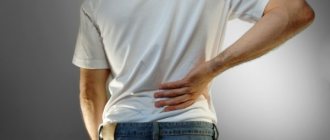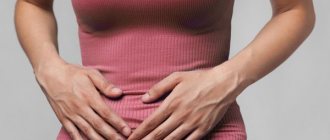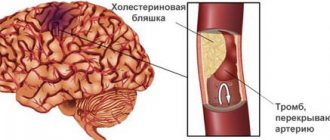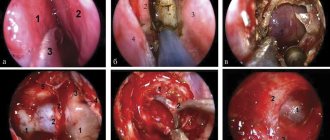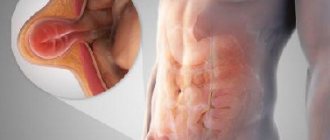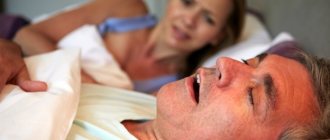- home
- Services and prices
- Proctology
- Hemorrhoids in men: symptoms and treatment
Hemorrhoids are varicose veins that occur in the rectum and anus. As a result of expansion, the veins undergo deformation, accompanied by the formation of hemorrhoids (HU). The density of their walls decreases, and they are more easily damaged.
In most cases, hemorrhoids in men are detected in the later stages of development. This is due to the fact that they are less likely to turn to a proctologist when signs of the disease appear, resorting to painkillers and local anti-inflammatory drugs, which temporarily reduce the severity of symptoms. However, the pathological condition continues to progress, posing an increasing threat to overall health. In order to avoid worsening the situation, it is recommended to make an appointment with a specialist at the first symptoms of hemorrhoids.
Causes of male hemorrhoids
The provocateurs for the development of the pathological condition can be different, but the main one is considered to be a genetic defect, which is the cause of congenital weakness of the walls of the venous vessels. The disease progresses under the influence of the following factors:
- Alcohol abuse, smoking.
- Prolonged sitting.
- Pathological lesions of the pelvic organs.
- Poor nutrition, as well as diseases of the digestive system, which cause stool disorders.
- Overweight.
- Low physical activity.
- Irritating effects of spicy and salty foods.
- Chronic cough.
Stress and regular heavy physical activity can trigger the development of the disease. In addition, provoking factors in men are prostate adenoma and prostatitis.
Contraindications
There are a number of contraindications that absolutely all doctors put forward during the course of treatment for hemorrhoids, so when you go to the clinic to treat hemorrhoids, you should pay special attention to this.
It is best to take into account each contraindication in the early stages of the disease. This will actively speed up treatment and, in principle, make it easier. By contacting a proctologist who treats diseases specifically related to the perineum, the patient will immediately receive an important contraindication. The first contraindication for hemorrhoids is refusal to lift weights. Excessive physical exertion can increase the pressure in the veins, causing blood flow to be delayed. If the patient has previously been involved in sports, then he needs to switch to more gentle training, reduce the weight load and the number of exercises. Another contraindication for hemorrhoids is that it is not recommended to wear tight underwear and tight outerwear. It is not recommended to engage in horse riding for people who have definitely been diagnosed with hemorrhoids. Another common contraindication for hemorrhoids is that you should never use soap or shower gels, as this can cause the skin to become even more inflamed. In this case, you need to use only natural soap with low alkali levels, otherwise the symptoms of hemorrhoids will become even higher. Doctors actively talk about what you should not do if hemorrhoids develop - eat fatty foods, since obesity can also cause the development of the disease.
Kinds
Effective treatment of hemorrhoids in men is possible with timely detection and the appointment of adequate therapy, which will be directly related to its type. Depending on the location in the anal canal, two types of disease are distinguished.
Outer
This condition occurs due to impaired blood circulation in the anal venous network, which entails dilation of blood vessels in specific areas with the subsequent formation of nodes. They are located directly under the skin in the area of the rectal-anal line located below.
The disease can occur in a normal or complicated form. It is characterized by bleeding hemorrhoids, which fall out and become pinched, and ulcers appear on them. This type of lesion of the veins in the anus occurs with clear clinical symptoms. Already at an early stage, it becomes a cause of discomfort in a person’s usual life, reducing its quality. Among the main manifestations are itching and painful sensations in the anus, which initially arise during the process of defecation, and then are felt constantly. Symptoms worsen with sneezing, physical activity and prolonged sitting.
Interior
This type of pathology is characterized by varicose veins that occur in the submucosal layer of the rectal canal. In this case, GIs appear inside on its walls. The occurrence of formations occurs in the thickness of the mucous ampulla of the rectum above the dentate region. It is in this place that the internal venous plexus is located.
Internal hemorrhoids in men are dangerous because they practically do not manifest themselves for a long time. However, as the pathology develops, hemorrhoids begin to fall out of the anus. Subsequently they become inflamed. A person begins to feel discomfort associated with the appearance of a burning sensation in the anus and its swelling, painful emptying of the colon and the appearance of traces of blood on toilet paper.
Bibliography
- Vovk, E.I. Hemorrhoids: emergency care, treatment strategy, prevention / E.I. Vovk. - Text: electronic // Russian Medical Journal, 2001 - No. 20. — URL: / (date accessed 12/26/2021).
- Clinical recommendations “Hemorrhoids”, 2020. Developer: All-Russian public organization “Association of Coloproctologists of Russia”. - Text: electronic. - URL: (access date 12/26/2021).
- Mudrov, A.A. Perioperative management of patients with chronic hemorrhoids/A.A. Mudrov.-Text: direct //Medical Council, 2012. - No. 3.- P.40-44.
- Rivkin, V.L. Modern ideas about the pathogenesis, forms and treatment of hemorrhoids / V.L. Rivkin. - Text: immediate. // Consilium Medicum, 2017. - No. 19 (7.1. Surgery). – pp. 57-61.
- Savelyev, V.N. Relationship between the incidence of hemorrhoids and professions and gender in the urban district of Izhevsk for 2015 and 2022 / V.N. Savelyev, L.I. Gadelshina, K.A. Merzlikina.- Text: direct // // StudNet, 2020. – No. 12 – pp. 14-19.
- Styazhkina, S.N. Hemorrhoids as a leading problem in proctology/S. N. Styazhkina, A.A. Khairullin, L.I. Gadelshina, K.A. Merzlikina. – Text: immediate // StudNet, 2022. – No. 4 – P. 19-21.
Symptoms of hemorrhoids
The disease in its acute form occurs with the formation of blood clots in the GU. Their increase in size and compaction causes acute pain, which is especially noticeable during rectal emptying. As a rule, bleeding is observed.
Among the main symptoms of hemorrhoids in men are:
- periodic loss of GU from the anus;
- bleeding from the anus on an intermittent basis;
- dysfunction of the prostate gland;
- a feeling of heaviness, as well as a sensation of the presence of a foreign body in the rectum;
- discomfort caused by burning and itching in the anus.
The most obvious sign of the disease is the appearance of bloody discharge from the anus, which is usually observed during reflexive excretion of feces in the form of scarlet splashes on the toilet or traces of blood on toilet paper.
Most men deliberately ignore contacting a proctologist when the first symptoms occur. They begin to sound the alarm when the pathology has developed to stage 2-3, in which frequent loss of GU is observed, provoked by coughing, laughing, and sneezing. In this case, their independent reduction does not occur, and the person has to do it with his hands.
There are often cases when patients seek help from a doctor already at stage 4. The knots fall out constantly and it becomes almost impossible to set them back. Their tendency to thrombosis increases. This brings great discomfort to a person’s usual way of life.
It is important to understand that visiting a doctor late greatly complicates the treatment process and makes it longer. Therefore, even at early signs of the disease, it is recommended to make an appointment with the protocol, which will conduct an examination and, if necessary, prescribe additional tests. This will help you quickly determine the cause of alarms and begin to eliminate them.
Further development of the disease
The question is often asked: what will happen if hemorrhoids are not treated? If the first signs are not clearly expressed, a person prefers to ignore them rather than go to the doctor with an unpleasant problem. However, delay can lead to complications and very unpleasant signs that can make life unbearable. Among them:
- Progressive inflammation with the formation of edema. It is difficult for the patient to sit; hemorrhoids constantly remind of themselves. Swelling may be accompanied by mucus secretion, accompanied by constant itching and burning.
- Sharp cutting pain during defecation. They talk about the appearance of anal fissures or the beginning of thrombosis. Such pain is one of the most obvious signs of hemorrhoids; when they appear, delay in treatment becomes truly dangerous.
- Nodes falling out. If damaged hemorrhoids are located near the sphincter, they may appear outward during bowel movements, and the patient has to manually reset them. Prolapse of nodes is a common symptom of hemorrhoids during pregnancy.
- Frequent constipation. Growing hemorrhoids do not allow innervation of the sphincter, so there is no urge to defecate. This further aggravates the problem, as there are even greater difficulties with bowel movements and digestion.
The further course of the disease is determined by the actions of the patient. If you start the treatment prescribed by your doctor, you can stop the development of the process and eliminate most of the unpleasant symptoms. If you postpone the problem “for later,” severe rectal bleeding, the formation of cancerous tumors and other serious complications are possible.
An additional factor that aggravates the course of the disease is treatment with numerous “folk remedies”. At best, they simply do not help, and the time for real treatment is delayed. Otherwise, they can lead to additional damage to the sphincter and rectum, which will only aggravate the patient’s condition and accelerate the development of complications.
How to treat hemorrhoids in men
The therapeutic program depends on the stage of the disease, the presence of complications and the general health of the patient. At the initial stage, medications showed effectiveness, including:
- venotonics;
- anticoagulants;
- analgesics;
- anti-inflammatory drugs.
In more advanced cases, they resort to surgical intervention, which involves both minimally invasive and radical techniques. The final decision on prescribing a specific treatment regimen is made by the doctor based on the diagnostic results.
Basic methods
The key methods that are successfully used today in eliminating hemorrhoids include:
- Infrared photocoagulation.
It is indicated in the early stages of pathology development in the presence of small GUs that practically do not fall out, and is performed without anesthesia using special devices. They generate a light flux that is focused a few millimeters from the place where the light guide is attached. The total number of such places is 3-4. They are located on the surface of the rectal mucosa in the projection of the vessels through which blood enters the GU. During the procedure, a person feels a slight burning sensation, and after it, a feeling of discomfort may appear in the rectal area. Short-term serous-serous discharge cannot be ruled out. - Latex ligation.
Most often it is prescribed at stages 2-3 of the disease and is carried out without anesthesia. The method is that a latex ring is thrown onto the base of the internal GU using a mechanical or vacuum ligator. During one session, it is possible to painlessly ligate no more than two nodes, which necessitates a series of manipulations in some cases. The method is recognized as the most painful among other minimally invasive techniques. - Sclerotherapy.
It is performed at stages 1, 2 and 3 of hemorrhoids without anesthesia. It is based on the sclerosing properties of medications that act on the inner lining of blood vessels, which can cause coagulation of proteins, vascular spasm and thrombosis with subsequent obliteration of the lumen. The specialist uses a syringe to inject a liquid or foam sclerosant through the anoscope into the GU in a non-sensitive area. As a rule, up to 2 nodes can be sclerosed during one manipulation. - Desarterization of GU under the control of Doppler ultrasound.
It is effective in the case of stages 2 and 3 of the disease and is performed inpatiently under intravenous or spinal anesthesia, or on an outpatient basis under local anesthesia. The method consists of transporting hemorrhoidal arteries at several points (6-8) using special needles and threads under the influence of an ultrasonic sensor a few centimeters above the GU. Next, the rectal mucosa is tightened and subsequently fixed together with the internal node. - Radio wave removal of GI.
We can use it at stages 3 and 4 of pathology under local anesthesia, if there is a need to remove and treat external hemorrhoids in men. With its help, internal GIs are also removed. It is characterized by minimizing trauma and thermal effects on tissue in the process of eliminating GU, which reduces the inflammatory response and pain, and also provides optimal conditions that promote rapid healing of wounds. The intervention is carried out practically without blood loss and the need for stitches.
Review of drugs
Drug treatment can be:
- Local with the prescription of oral medications that eliminate the cause of the disease and reduce the severity of symptoms. Ointments and gels help speed up the process of tissue repair.
- Systemic, aimed at increasing venous tone, reducing vascular weakening and increasing lymphatic drainage.
The following drugs are indicated for the treatment of pathology:
- Venosclerals, which are surface-active compounds that act on endothelial damage and obliteration of venous structures.
- Hemostatic agents based on natural polysaccharides and having anti-inflammatory, reparative and hemostatic effects.
- Anticoagulants intended for local application and characterized by anti-edematous and anti-inflammatory effects, as well as promoting the regeneration of connective tissue.
- Antimicrobial, preventing the development of infectious processes.
- Venotonics, the action of which is aimed at increasing the tone of smooth muscle structures and reducing the permeability of venules. They help increase the density of vessel walls, eliminate swelling and relieve inflammation.
- Antispasmodics that reduce pain and spasms.
Conservative therapy
Treatment involves the use of local and oral medications. Almost all drugs have a complex spectrum of action; a specific type is selected by the doctor in accordance with the complexity of the pathological process and the general condition of the body.
Therapeutic procedures are carried out using:
- anticoagulants and antiplatelet agents - Gepatrombin, Geparoid Zentiva, Lyoton;
- hemostatic agents - Relifa, Troxevasin, Methyluracil, Troxerutin;
- venotonics - Indovazin, Aescin, Procto-Glivenol, Reparil, Venoruton, Essaven;
- anti-inflammatory - Doloproct, tetracycline and syntomycin ointment;
- hormonal - Proctosedyl, Ultraproct, Advantan, Aurobin, Hydrocortisol;
- immunomodulators – Posteinase, etc.;
- astringents - Bezornil, Proctosan;
- antiseptic - Levomekol, ichthyol ointment and Vishnevsky liniment.
Homeopathic medicines can be used during therapy: Aesculus, Phlebodia 600.
In addition to external agents, systemic venotonics may also be included in the regimen. Tablets are prescribed in the primary stages of pathology and as a means of preventing it. With their help, they get rid of venous stagnation, tissue swelling, and suppress the inflammatory process.
Systemic drugs are prescribed if the following indications exist:
- pain syndrome, bleeding;
- constipation - to soften fecal stones;
- the need to prevent the development of the disease or prevent the penetration of secondary infection.
Therapeutic procedures are carried out with Detralex, Venarus, Venoruton, Pilex, etc. During treatment, the patient must give up smoking and alcohol, switch to a balanced diet, not lift weights, and normalize the work and rest schedule.
How to relieve pain from hemorrhoids
Pain is a frequent accompaniment of the disease. If it becomes unbearable, then you can use local medications that will help eliminate it temporarily. For example, the following ointments will help effectively cope with pain from hemorrhoids:
- Levomekol.
- Troxevasin.
- Heparin ointment.
If we are talking about older people, then we should give preference to Fleming’s ointment, based on natural ingredients.
Elimination of pain is not a sign of recovery. Therefore, you should not postpone your visit to the doctor.
What to do during an exacerbation
In case of exacerbation of the pathological condition, you should refuse self-treatment and immediately seek help from a doctor. He will conduct an examination and decide on the prescription of adequate therapy, which will stabilize the condition and reduce the risks of developing possible complications.
Doctors treating this disease
People who suffer from hemorrhoids and do not understand doctors often wonder which doctor treats their disease.
A specialist such as a proctologist deals with the professional treatment of hemorrhoids. Therefore, you should consult a doctor if hemorrhoids actively progress. It treats all diseases related to the perineum, colon, rectum and colon. The doctor diagnoses the possible development of diseases, prescribes prevention, gives a list of indications, and tells the approximate cost of treatment. The task of a proctologist is to cure perineal disease, polyps, and anal fissures. Every proctologist knows what not to do for hemorrhoids. He is professional in his work and is always ready to remove hemorrhoids. This doctor treats an individual patient's hemorrhoids. That is why you need to look at the list of doctors in order to decide on the necessary treating professional who will cure hemorrhoids in the clinic.
Prices at the Yuzhny clinic
| Service | price, rub. |
| Consultation with a proctologist, center director | 2500,00 |
| Consultation with a surgeon, candidate of medical sciences (branch on Krasnaya Presnya) | 2600,00 |
| Consultation with doctor of medical sciences, professor | 3000,00 |
| Consultation with a proctologist, candidate of medical sciences | 1800,00 |
| Consultation with a proctologist, candidate of medical sciences (branch on Krasnaya Presnya) | 2600,00 |
| Consultation with a proctologist | 1600,00 |
| Treatment of anal fimbriae and residual hemorrhoidal marks 1 pc. (radiosurgery method) | 6600,00 |
| Treatment of hemorrhoids using radiosurgery (1st degree of complexity) | 8700,00 |
| Treatment of hemorrhoidal node RCM (2nd degree of complexity) | 12100,00 |
| Laser vaporization of hemorrhoids | 38500,00 |
| Laser vaporization with disarterization of hemorrhoids | 49500,00 |
| Desarterization of hemorrhoids with mucopexy | 38500,00 |
Yuzhny Medical Center offers the opportunity to make an appointment with experienced proctologists who will help identify the disease in time and begin its treatment, selected individually for each patient. Reception is carried out on a paid basis. Its cost varies depending on a number of factors and is announced by a specialist after consultation.
How to get rid of hemorrhoids at different stages
Hemorrhoids will recur after conservative treatment in approximately 50% of cases, while the recurrence rate after surgery is only 5%. The goal is to control hemorrhoid inflammation through diet and hydration so that surgery is not required. In this regard, hemorrhoids are a lifelong condition that needs to be managed.
Hemorrhoids of 2 and 3 degrees are initially treated conservatively or using minimally invasive methods. These include injections into the hemorrhoidal vein to sclerosize or harden it, using rubber bands to cut off the blood supply and cause the hemorrhoidal tissue to shrink, or other procedures that cause the lining to shrink and die.
What not to do for hemorrhoids?
Most of the restrictions associated with hemorrhoids are aimed at causing the connections that lead to its development. They all come down to stabilizing the blood circulation of the pelvic organs. It is not prohibited to play sports, but you should avoid “sedentary” sports. Heavy lifting needs to be eliminated.
You should not eat foods or drink drinks that cause gas formation. These include sweets, legumes and soda. It is imperative to exclude salty, spicy and fatty foods from the diet.
Methods for preventing hemorrhoids
To avoid the occurrence and exacerbation of hemorrhoids, it is necessary to teach children from an early age to prevent the disease. Well, for those who are already susceptible to it, it is important to carefully observe measures to protect themselves from exposure to factors that cause the development of inflammatory processes.
- Do not sit for too long, you need to get up and walk for a few minutes, this will protect against stagnation of blood circulation.
- Do not smoke, give up alcohol.
- Perform exercises that train the elasticity of the gluteal and abdominal muscles.
- Maintain personal hygiene in the perineal and anal areas.
- Eat high-quality healthy food, with a predominance of vegetables and fruits.
- Avoid spicy marinades, pickles and mucous-irritating spices.
- Eat as little smoked and fried foods as possible.
- Dress according to the weather to avoid colds.
- Expectant mothers carrying a child prone to constipation need an increase in laxative foods.
Most importantly, never engage in uncontrolled self-medication using dubious recipes advertised by who knows who. In order not to expose your health to the risk of hemorrhoids from a young age, you just need to give up bad habits. The disease will not overtake you by surprise, and, if it has already appeared, a correct lifestyle will save the body from exacerbations.
Timely diagnosis
To avoid hemorrhoids and possible complications, it is necessary to identify the disease at its earliest stages. Internal hemorrhoids can be detected by digital examination of the rectum, feeling for compaction of the hemorrhoidal veins. But such an examination is effective only when the nodes are located low. If the cones are located high up, then only modern equipment can help in diagnosing the disease. Anoscopy and sigmoidoscopy are the most common techniques. In the first case, a special tube with an optical device is used, which allows one to examine the rectal mucosa over a ten-centimeter length. If the hemorrhoids are located even higher, then you cannot do without the help of a sigmoidoscope. The rectum at a distance of 25 cm will be “in full view” to the doctor. If the patient states that during defecation he himself observed the prolapse of nodes, then a diagnosis can be made based on this reliable fact. True, unfortunately, for the patient the stage of the disease in this case is later, and therefore less treatable.


